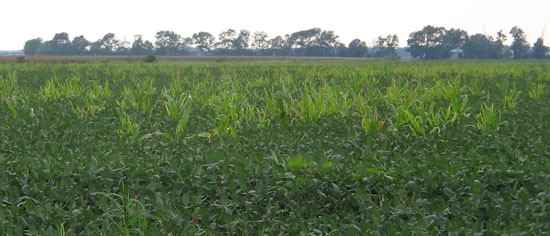With more acres of soybeans being planted and more dropped ears during corn harvest, volunteer corn is becoming a larger issue for Illinois growers.
Areas across Northern Illinois experienced 2018 harvest conditions where some of the corn crop didn’t make it to the bin. After the combine had harvested a corn field, it wasn’t uncommon to have more than 10 bushels/acre of grain left in the field. We also experienced weather conditions that were not conducive to fall tillage which helped lost ears germinate, in many cases before a winter freeze.
Volunteer corn competes with soybeans for nutrients, water and sunlight. After hatching, it is also a host for corn rootworm as well as a trap crop, attracting corn rootworm beetles if allowed to enter silking stage. These events further reduce the impact that including soybeans in rotation has on corn rootworm management, as well as decreasing soybean yields.
So, how should I manage the abundant ears per acre that were left in the field from 2018?
 |
| Volunteer corn can cause problems for soybeans as it competes for nutrients, water and sunlight. Image courtesy of Illinois IPM Bulletin. |
Spring tillage can be an effective way to kill emerged volunteer corn. This approach can resize ears, effectively planting ears and kernels in a broader manor than if they were left intact.
Delaying planting soybeans to manage volunteer corn puts bean yield potential at risk from a planting date standpoint. And early season control of volunteer corn is important even after soybean planting because competition from the volunteer corn impacts soybean growth.
Herbicide management is an effective tool for managing volunteer corn, but most of the volunteer corn is tolerant to glyphosate and glufosinate. Many pre-emerge soybean herbicides such as Prefix®, Treflan®, Prowl®, Command®, Pursuit®, Scepter® (in the South) and Canopy® can stunt corn growth and reduce the competitiveness of volunteer corn in soybeans. Post-emerge grass control products in soybeans such as Fusilade® DX, Fusion®, Select Maxx®, Assure® II and Poast Plus® may be tank mixed with other herbicides to control volunteer corn in emerged soybeans. Some tank mix partners restrict the use of AMS, NIS and oils so increasing the rates of post grass herbicides may be needed to get desired control (especially with tall volunteer corn).
To learn more about the impacts volunteer corn can have on yield click this link.


 and then
and then